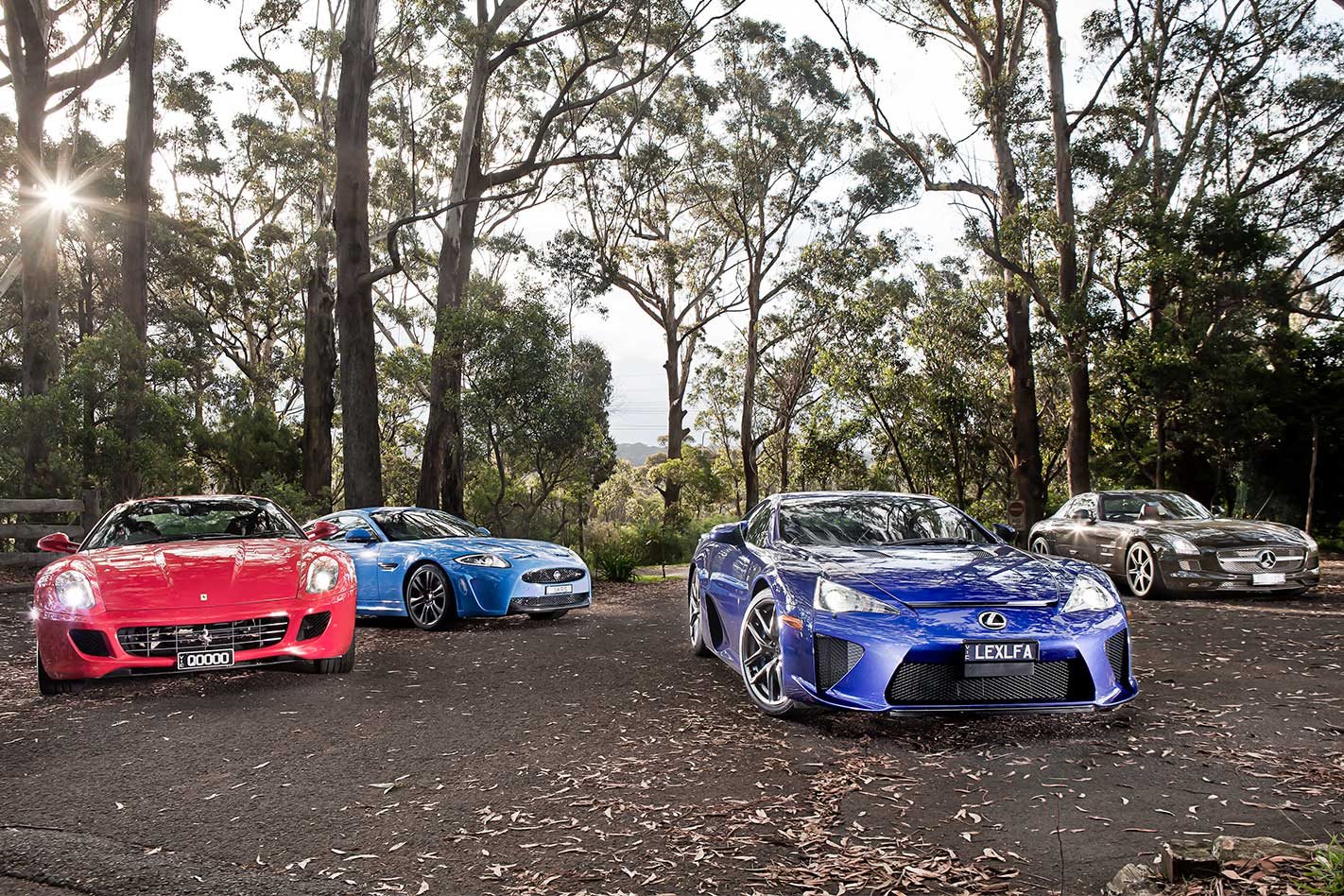Mmm… I’m eating humble pie right now. And it tastes very very good.
This feature was originally published in a previous issue of MOTOR
I was the cynic who made fun of urban billboards marketing the Lexus brand off its LFA halo car. A cheap ploy to move product using a car, I joked, that didn’t actually exist. An enigma, I reckoned, that is so expensive, so exclusive, so rare and, frankly, so firmly planted in La La Land in any pragmatic motoring sense that, frankly, I’d only believe it when I saw it, mixing it with the great unwashed Falcodores on Aussie streets.
And yet here I am, tootling The Lexus of the Gods down Sydney’s Princes Highway in peak hour, one eye on a taxi ahead merging dangerous close to this $700,000 fairy tale on wheels. Today I’ll be the first journo in Australia to let LFA off its leash in public.
You know you’re in for a surreal day when you assemble four cars and Merc-Benz’s exotic SLS AMG is, at $468,820, one of cheapies. And when the field’s average price is a smidgen over a half-mil. But on only a few kays in, and barely out of second gear, the creeping feeling is that the complexion of this shootout will only get stranger.
The idea is innocent enough. Take the most outlandish front-engined – or front-mid-engined, to be precise – supercar ever to come out of Japan and pit it against the fittest and finest FR-layout kindred spirits from across the globe. Of course, nothing says business up front and party out the back (wheels) in German than Merc’s Gullwing. Or, perhaps, a Deutsch mullet.
Ol‘ Blighty (by way of India these days) is represented with fastest and most-powerful Jaguar ever created, the XKR-S, which, in this company, looks like chump change at $340,000. Especially when its half the price of our Italian representative.
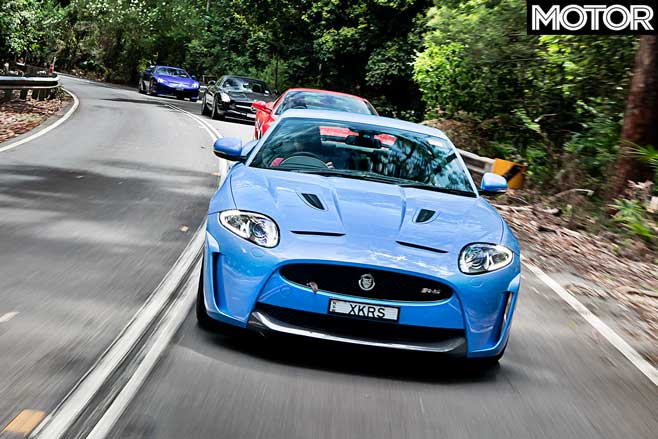
And when you’re talking supercars, and perhaps LFA’s most logical competitor, you simply must have a Ferrari of the V12-powered 599 persuasion, in our case a Fiorano GTB 4. Yes, there’s a hotter GTO version of the 599 out there, but the Gran Turismo Berlinetta lobs into the fray at an LFA rivalling $677,250.
Ferocious? You bet. Nothing here dips under 400kW. And horsepower wise the quartet is much closer than are on pricetags. The Jag uses supercharging on its 5.0L V8 to nail, the Merc uses cubic capacity (6.2 litres) to make its 420kW. And the LFA uses rpm, and its hellacious 9000rpm redline, to split the former pair neatly, with 412kW. Meanwhile, the top dog Ferrari musters big cubes and high rews to extract a lofty 456kW from its 6.0-litre V12. So far so fair…
But every passing gearchange and every fresh kilometre under its Bridgestones deepens a sense that the LFA sits further out on motoring’s extreme fringe than the rivals it rendezvous with south of Sydney. And having all of them sit present, correct and silent at the gates of the Royal National Park, further cements this idea.
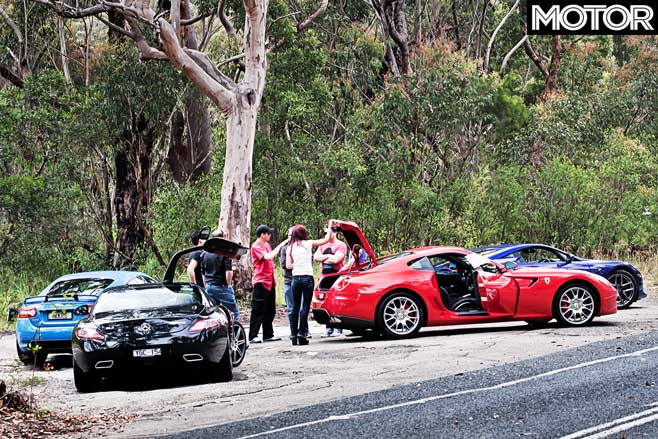
The LFA isn’t handsome. But it is low, purposefully and holds greater presence in the flesh than it does in photos, even in its reserved blue paintwork. Its techy, carefully wind-tunnelled lines are there to please airflow, not aesthetics.
It’s the antithesis of the 599, which no doubt owes its gorgeous shape to Pininfarina’s heart and hands, pencil and paper. And while the SLS’s styling harmonises opinion like sexual politics, it’s got X factor and character in droves, two things the ‘look-at-me!’ bright blue Jag almost desperately wants, but its gentleman-in-gym-pants presentation doesn’t quite pull off.
Bonnets up, doors open, there’s a keen inspection of the nitty gritty before the much anticipated ceremony of uncorking 1963kW in unison. And, surprisingly, it’s LFA’s ‘cockpit’, as Lexus calls it, that brings its fringe-dwelling essence into sharp focus.
While both the Benz and Jag are rich and opulent inside – the Merc stylishly so, the XKR-S ostentatiously so – and the Ferrari presents a (frankly incoherent) mishmash of flamboyance, style and carbon-overkill motorsport, the LFA presents like a futurist concept car turned reality. And with zero compromise.
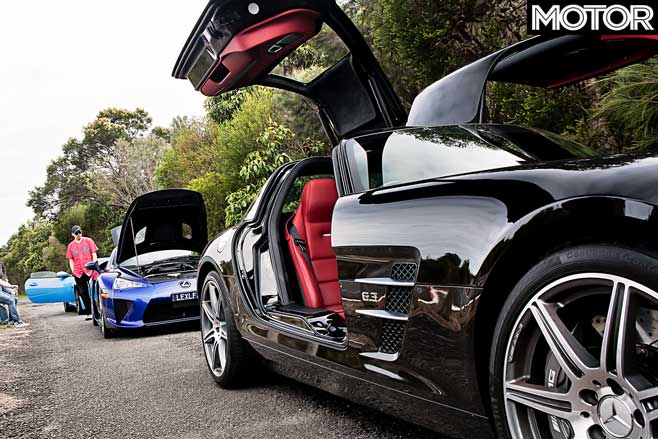
From the minimalist controls in high centre console to the Lexus engraved screw heads; from the impossibly techy LCD/TFT central rev-counter – motorised to move sideways in the instrument cluster – to the one-piece forged floor-mounted pedals; from its innovative air-bag seatbelts to the F1-style carbon-fibre flat bottom steering wheel; the whole shebang screams bespoke, no-compromise precision. Nothing (apart from the centre screen/satnav) seems parts-binned or derivative. Everything presents a feeling of no-fat purity. Everything has been honed to perfection. How much honing?
That it took and entire decade to develop isn’t nearly as eye-opening as that fact that, five years in, it was decided aluminium construction wouldn’t cut it. So they took and engine, gearbox and not much else out, scrapped the lot, and started anew with its now 65-percent carbon-fibre construction.
That, in nutshell, is what LFA is about. It’s not simply unlike any other Lexus, in some areas it couldn’t be more opposite.

The SLS comes closest to matching LFA’s bespoke exclusivity, and yet its cabin still feels all that separated from lesser Benz stock. The Jag – the only car here with rear seating – feels heaped with layer upon layer of added opulence, but can’t escape its regular and ageing XK essence. And despite its beautiful carbon-shelled buckets, lush surfaces and a sense of heritage seeping from its leather pores, the 599’s switchgear screams ‘Fiat’, it lacks the solidity of its rivals, and much of the handmade stuff, such as the dash pad stitching, looks to have been whipped up in the hurry.
Don’t get me wrong; the Euros are top-shelf by all measures…unless you benchmark them against the LFA, when shortcomings and compromises appear. It’s as if the LFA was hand-crafted by its own skunkworks. And that skunkworks (Lexus LFA Works, as it’s called) had absolute freedom to stretch its engineering and design talents to their limits, costing be damned. And that’s exactly how the Japanese supercar came together.
Four start button on ‘go!’, 38 cylinders ceremoniously part the national park skies. It’s more a cacophony than symphony, the Merc and Jag filling the throbbing low frequencies, the Lexus and Ferrari cutting through with the highs, their vastly different characters struggling for harmony.
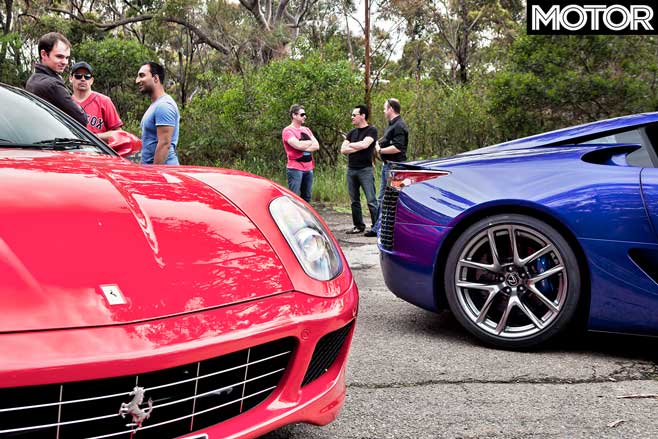
The bass section is a familiar one; we’ve tested both the Brit and German numerous times to date, including last issue’s PCC2011. And though the scalded cat’s immense tyre-ripping, tail-squirming low-end shove is expected, it still brings a slight, grin-inducing surprise. Its key characteristic is its force-fed shove: 680 head-slapping Newtons at a casual 2500rpm, we’ll before it fully opens is lungs for a distinctly guttural, bent eight roar.
It delivers its energy like a swung baseball bat and its sport-tuned ZF six-speed auto is fine companion for metering out the shove with a semblance of composure. And the real beauty of the Jag experience is that it’s effortlessly flexible, composed and surefooted simply via easing out of the loud pedal, and as potent as a poked lion if you dial up its dynamic mode and give it a swift kick in the slats.
In today’s company, the usually visceral SLS presents a sort middle ground of the field. It needs 4750rpm for its 650Nm sledgehammer attack, is urgently tractable down low, rewards the harder and higher you rev it, feels blisteringly brisk, and its fat throb could well be the eighth wonder of the world.
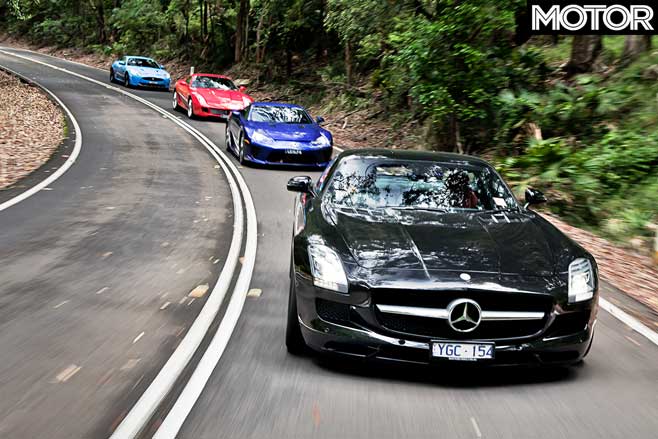
Despite appearing larger, the 1620kg Merc is a substantial 133kg lighter than the Jag and it monsters the blacktop more effortlessly. Its closer-stacked seven-speed DCT – the only twin-clutcher here – is the class of the field, almost silken in Comfort mode, rapid-fire in either Sport or Sport+ mode, and pretty much indicative of the Gullwing’s character.
Where the Jag feels the gentleman’s coupe with (literally) two layers of performance enhancement added, the SLS is more a proper super grand tourer, all the manners of an open road hauler but with supercar levels of bona-fide vibe and ability. The Merc is both more relaxed and confidently quicker of the two up a back road.
The 599, and its front-engined Ferrari forebears, pretty much created the super gran turismo mould. Oh, there’s supercar DNA in spades: its bent 12 lifted from the legendary Enzo, its F1 sequential six-speed manual gearbox largely derived, conceptually, from its namesake, F-Trac stability smarts and tiller mounted manettino dial, complete with Race mode. All in dignified coupe that comes with its own leather-strapped boutique luggage compartment.
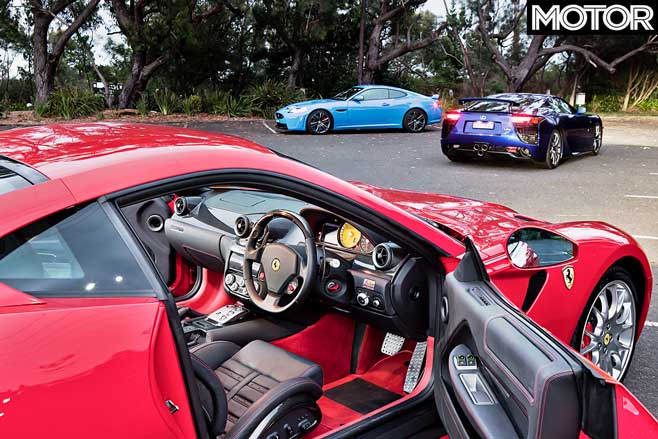
There’s 608Nm on tap – 42 down on the SLS, 72 down on XKR-S – and arrive well up there, at 5600rpm. But you don’t have to be card-carrying tifosi to get lost in the in the romance of
The surprising thing about the Ferrari is how light it feels both in its tangible controls – steering, brakes, throttle – and in its lateral acceleration. That’s because, at a Jag matching 1753kg, it quite portly. And while it doesn’t feel as ponderous and wallowy as the Brit in a general sense, you can feel the mass when firing the 599 through tighter curves. The Italian is engaging and lively – it doesn’t take much provocation for those huge 305mm rear Pirelli P Zeros to cry freedom – but there’s not as much hunkered down road holding grip or strident body control as the SLS musters up in the tighter stuff.
Both the 599 and SLS have meaty and nicely weighted steering, the latter, with its lighter kerb weight, keener to keep its front hoops biting into the hotmix through the middle of a corner. Perhaps the biggest dynamic letdown of the pack in the Jag’s steering: good by most measures, but against this lot it feels dull off centre, lacks bona-fide weight and communication, and anything but linear in front end grip as you pile on steering lock.
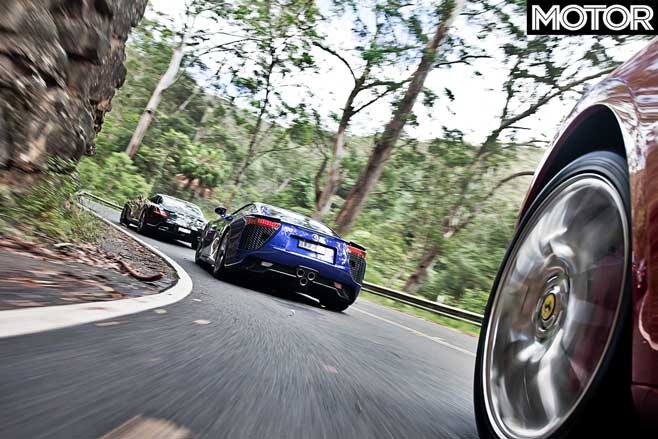
In short, they’re three distinctly different back road, hard-punt characters. The Jag feels immensely solid, comfortable but lacks dynamic conviction. The Ferrari is lively but misses out on a bit of ten-tenths sharpness and solidity. And the Merc is quick and grippy but a bit lifeless in the proceedings. But all are events to drive, and all offer plenty of feel-good vibe and thrills.
And then there’s the LFA. Which is on another planet.
Poke the carbon Start button and it suddenly ‘braps!’ before settling into a quiet idle. A rotary dial to the right of wheel selects the drive modes, reconfiguring the instrument from normal (black) to Sport (white). Below it is another dial for changing shift mapping for the six-speed, single-clutch/single-shaft gearbox that, in functionality at least, is cut from the old-school Lambo and Ferrari ethos.
That is, it’s literally sequential – it can’t jump ratios – and it’s complicated to use. Auto-shift mode demands its own button. Reverse its own switch, ditto the parking brake. Neutral requires pulling both exquisite column-mounted shift paddles. Three-point turns are, frankly, a long-winded nightmare.
Other vital stats make interesting reading. Its 72deg 40-valve V10 makes 412kW power peak at an extraordinary 8700rpm.
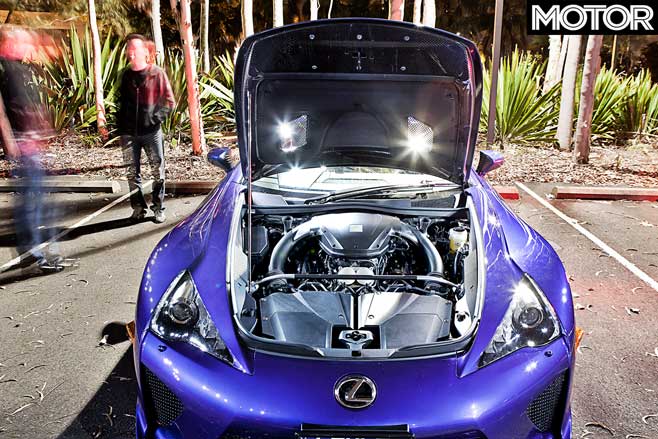
Harness its launch control, a 4000rpm clutch-dumper, and Lexus claims it’ll march from zero to 100km/h in 3.7sec. Or exactly what Ferrari claims for the 599, and one-tenth quicker than Merc’s figure for its SLS. Feasible? Well, the LFA as it sits here weighs just 1540kg, though delete-optioning its specs can, if a buyer wishes, drop that figure below 1500. Or around 275kW per tonne.
It’s the top of third gear when it happens. From a standstill, you dial up Sport mode, grab first, nail the throttle and at 3000rpm the active exhaust unleashes full volume and, by five grand you instinctively grab second because the engine sounds to be spinning hard. Nope. Second gear you hold it longer, a pure, visceral, banshee howl spiralling higher in pitch from its triangular exhaust stack, and you instinctively slap the paddle at around 7000rpm. Nope. Still short. Peak torque, a mere (in this company at least) 480Nm has only just clocked.
Bang! The upshifts are brutal, and mind-bogglingly instant. And so, in third, you finally commit, right foot buried, finger tips poised, needle sweeping past 7000rpm towards its 9000rpm target, and then…
“Oh…my…gawd!” …bang!
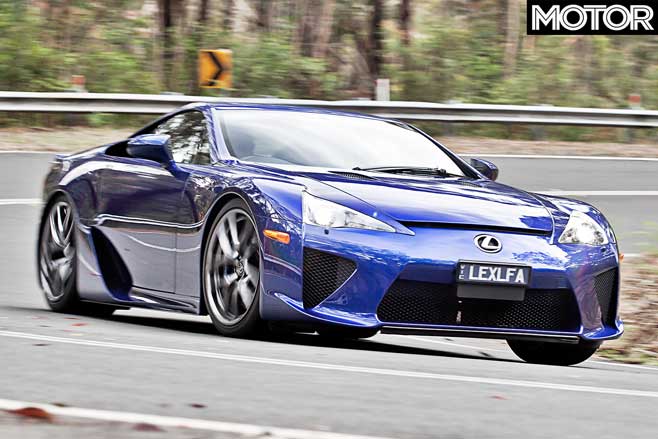
No other road car has an engine quite like this. That wail. That fury. It’s like Formula One with the volume knob turned down. Smooth? Beyond butter. I’d wager if you sat in the LFA wearing ear muffs you wouldn’t tell by feel if the engine was actually running. Linear? You could play billiards across its power curve.
There’s more. The engine’s formula motorsport sheen extends to liveliness. It revs so cleanly and quickly, virtually unimpeded by noticeable rotating inertia. Its punchiness and response to minute throttle inputs in the mid-range, at around 4500rpm, is simply startling. And you’d trade any amount of low-end shove for its breathtaking character that demands you rev it way beyond reason and rewards – massively – with a feel-good vibe even six litres of Ferrari V12 can’t come close to matching.
Yeah, that good.
One by one the MOTOR crew rotate through the cars, each one stumbling out of the LFA giggling like school boys. It’s more than just the engine.
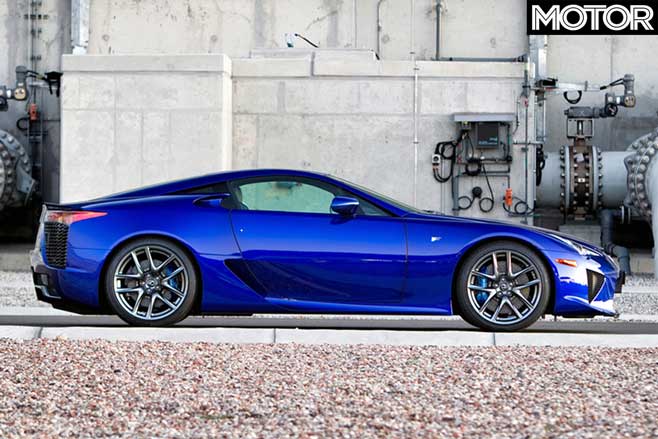
The speed and seamlessness of the downchanges is incredible. And beyond the sheer stopping power of its carbon-ceramic 390mm/360mm monobloc brakes – the Ferrari has equally mega stoppers – is the accuracy of the pedal feel.
What’s really surprising is how light and nimble it is – MOTOR cohort Ponchard remarks that it actually feels 100 kegs lighter that its claimed kerb weight. Oh, there’s some clever number crunching going on underneath: its Sport VDIM (Vehicle Dynamics Integration Management), which holistically governs everything from traction and stability smarts to engine mapping, has a cleverdick “road camber angle estimation system” in its arsenal. And there’s active aerodynamics, too.
But you never sense it operating. Even at a seriously hot pace the LFA never ever seems artificial. It just goes about bending physics with cornering grip, poise, balance and confidence-inspiring surety unmatched by anything the sane side of a Porsche GT3. With a lithe sense of driver engagement Nissan’s GT-R could only dream about.
Then there’s its electric-power-assisted steering. It’s perfect. Not great. Not excellent. But perfect. It’s amazingly linear, not over-ratio-ed, has an oversized shaft, hard-mounted rack and superlight hard-touch carbon tiller. And the only way you’d create a clearer, more intimate communication with the road is if you’d open the driver’s door and touch the hotmix with your fingertips. Yep, that good.
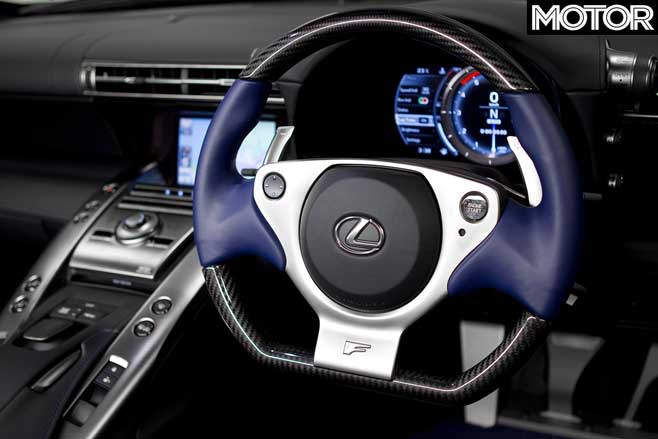
The LFA doesn’t have adaptive suspension. Its ride’s not unlike that of a Porsche GT3: firm but not crashy, a sheen of compliance. But what seems an oversight for the (set-damper) SLS package actually makes sense with the Japanese supercar’s ethos. See, switchable dampers might’ve robbed the LFA of detail in the sensory experience. Detail so fine you mightn’t have otherwise missed it. But Lexus LFA Works knew there was fine detail to be gained, so pursued it.
That’s what the LFA is all about. Absolute precision. Zero compromise. Regardless of, in this situation, comfort. Or cost. Or pricetag.
The Toyota Corp might’ve in fact garnered more street cred building LFA far simpler, cheaper, heavier (predominantly in steel) and with less efficiency, charged $160K, called it ‘Supra’ and gone chasing GT-R. And it’d be a much lesser car (and given its lightweight techy construction, more future-proof than the Nissan, too). It could’ve been primarily alloy and derived off an existing vehicle, pegged at $300K or so, and gone hunting 911s. But it wouldn’t have been nearly as bespoke. Or special.
In fact, not much this side of a McLaren MP4-12C or Lambo Aventador can blend bleeding-edged tech with such an incredible vibe and ferocious abilities. And, as we discover, Ferrari, Merc or Jag treatments come up short against the LFA’s pin-sharp focus of front-engined supercar greatness.
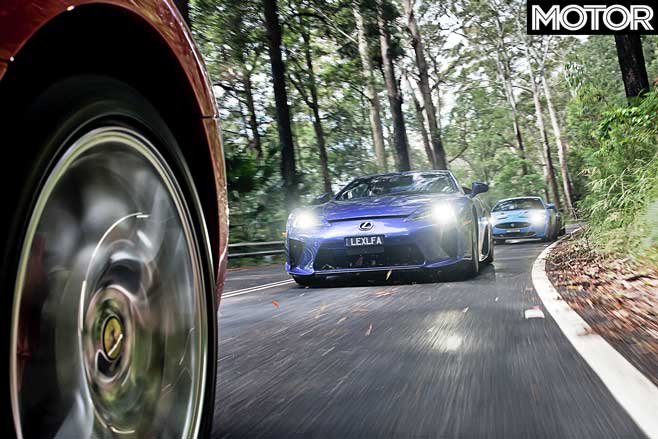
How quick the LFA is – startlingly – against the stopwatch isn’t the point. Its pace is one tool in its armada. And there are plenty of cheaper cars that are equally as quick on strip or circuit. Nope, the LFA’s most significant virtues are measured by feel, through your finger tips and spine, through its hyper-channelling extra-sensory experience that much more obvious, and eye-widening, on a twisty back road than it is on a track or dragstrip.
A shame, then, that with only three LFAs currently in Oz, and only another seven allocated for local sale, so few punters will get to sample its extraordinary essence well beyond the badge, output figures, pricetag or laptimes.
On a brighter note, Lexus were so impressed with the LFA Works blokes’ handiwork that the once independent skunkworks is now overseeing mainline product. Like the platform underpinning the next-gen IS – exciting news for those of we petrolheads not living in a La La Land paved with gold.
But until then, Lexus, can we have another taste of that pie?
Can a front-engine car be a supercar?
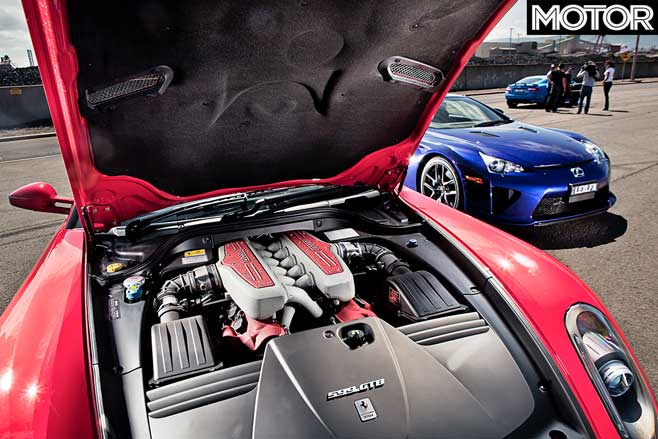
The concept of the front-engine supercar might seem foreign to many petrolheads who don’t have a senior’s card or wear an anorak sporting old Martini Racing patchwork. But history proves that before the most ferocious of road cars located their engines behind the cabin they pretty much all situated their powerplants in front of the driver.
Sure, mankind has explored all drivetrain layouts since time eternal and mid-engined racecars such as Benz Teardrop and Auto Union turned up in the ’20s and ’30s. But the rear-engine-equals-performance-domination idea didn’t catch on until the ’60s: first in formula motorsport with the Cooper-Climax T53, and a few years later, in 1966, Lamborghini’s Muira introduced the notion of a mid-/rear-engine uber-car. It took Lambo’s Countach, first unveiled in 1971with its rear-mounted V12 located north-south and with a transaxle, that the mould set on this relatively modern notion of a supercar.
You could call these four ‘classic’ supercars, so to speak. Their layouts boast the business up the front and the party, as far as driven wheels are concerned, up the back. So, mullet style, perhaps, though there’s nothing much bogan about any of the quartet.
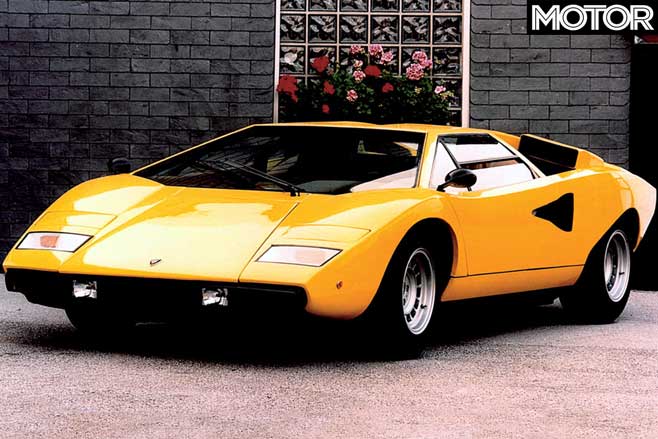
These are the most expensive, exclusive and exotic front-engined performance cars of their respective nations that serious money – the average price among them is the high side of a half-million – currently buys.
Well, almost currently buys.
The Prancing Horse here, the 599 (in Fiorano GTB 4 specification), is in the throw of doing its final laps of the Maranello stables and is being put out to pasture. But until Ferrari drops with a new V12-powered flagship, the 599 breed, which in GTB-trim derives its astonishing 456kW/608Nm 6.0-litre heart with the now-defunct Enzo, is the ultimate Italian two-seater FR expression of the super gran turismo.
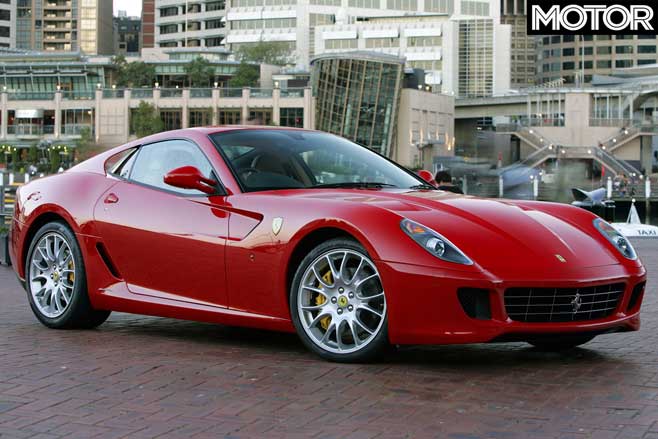
Ferrari has built a deep – thought not completely unbroken – heritage of offering front- and rear-engined mega-exotics. And deeper than any other car maker you can name. While rival Italians continue to promise variety in their ranges, Ferrari continues to deliver.
Representing Germany here is Mercedes-Benz. Like the Ferrari, its SLS AMG halo car trades on a rich sportscar heritage, specifically that of the 300SL. (And, like Ferrari, it’s technically a front-mid-ship engine placement.)


